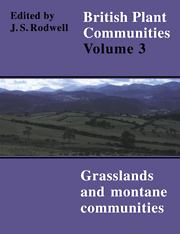Book contents
- Frontmatter
- Contents
- List of Figures
- Preface and Acknowledgements
- Preamble
- Mesotrophic Grasslands
- Community Descriptions
- Calcicolous Grasslands
- Community Descriptions
- Calcifugous Grasslands and Montane Communities
- Community Descriptions
- Index of Synonyms to Grasslands and Montane Communities
- Index of Species in Grasslands and Montane Communities
- Bibliography
CG12 - Festuca Ovina-Alchemilla Alpina-Silene Acaulis Dwarf-Herb Community
Published online by Cambridge University Press: 04 July 2020
- Frontmatter
- Contents
- List of Figures
- Preface and Acknowledgements
- Preamble
- Mesotrophic Grasslands
- Community Descriptions
- Calcicolous Grasslands
- Community Descriptions
- Calcifugous Grasslands and Montane Communities
- Community Descriptions
- Index of Synonyms to Grasslands and Montane Communities
- Index of Species in Grasslands and Montane Communities
- Bibliography
Summary
Synonymy
Arctic-Alpine grassland Smith 1911 p.p.; Sibbaldia procumbens nodum Poore 1955b p.p.; Dwarf Herb nodum McVean & Ratcliffe 1962; Myosotis alpestris localities Elkington 1964 p.p.
Constant species
Agrostis capillaris, Alchemilla alpina, Deschampsia cespitosa, Festuca ovinaIvivipara, Luzula spicata, Selaginella selaginoides, Sibbaldia procumbens, Silene acaulis, Thymus praecox.
Rare species
Alchemilla filicaulis ssp. filicaulis, Cerastium alpinum, Draba norvegica, Euphrasia frigida, Loiseleuria procumbens, Minuartia sedoides, Myosotis alpestris, Omalotheca supina, Poa alpina, Potentilla crantzii, Sagina saginoides, Saxifraga stellaris, Sibbaldia procumbens, Veronica alpina, Aulacomnium turgidum, Barbilophozia hatcheri, B. lycopodioides, Lescuraea incurvata.
Physiognomy
The Festuca-Alchemilla-Silene community comprises rich mixtures of grasses and herbaceous dicotyledons which, with bryophytes, form a very distinctive kind of short (usually less than 10 cm) and sometimes rather open sward. Floristically, the vegetation has much in common with the Festuca-Agrostis-Alchemilla grassheath. Festuca ovina, F. vivipara, Agrostis capillaris (with some A. canina’) and N ardus stricta all remain frequent here and, with Deschampsia cespitosa, which rises to constancy in this community, they can make up a substantial proportion of the sward. Alchemilla alpina, Thymus praecox and Selaginella selaginoides also remain very common and A. alpina especially can be locally abundant. Usually, however, it is the cushionforming Silene acaulis and, less frequently, Minuartia sedoides or the tufted Sibbaldia procumbens which give the vegetation its unmistakeable stamp, forming on occasion a discontinuous velvety carpet in which the other species are rooted. Although each of these occurs in other montane vegetation types, among the more calcicolous communities it is here that they make their strongest contribution.
Moreover, they are accompanied, with varying degrees of frequency, by a wide variety of montane plants, mostly Arctic-Alpines, some with very restricted distributions in Britain, which make this one of the most renowned of our vegetation types. Most frequent among these are Luzula spicata, Saxifraga oppositifolia and Polygonum viviparum with, less commonly, Antennaria dioica, Salix herbacea, Omalotheca supina, Thalictrum alpinum, Juncus trifidus, Euphrasia frigida, Epilobium anagallidifolium, Alchemilla filicaulis ssp. filicaulis and, especially distinctive of this community, Sagina saginoides and Cerastium alpinum (this last sometimes hybridising with C. fontanum which is occasional in the community: Stace 1975).
- Type
- Chapter
- Information
- British Plant Communities , pp. 254 - 258Publisher: Cambridge University PressPrint publication year: 1992

